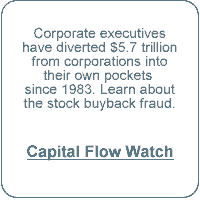 Motivation: Foreign Investors in US Bond Market
Motivation: Foreign Investors in US Bond Market
Seeking Motives
Complex Motivation
Examination of motives of fund managers, of course, does not stop with their investment decisions.
Equity fund managers also exercise voting rights on the stocks they have in portfolio.
As a class, fund managers have enormous influence on the behavior of public corporations and so we must ask also, what motivates fund managers regarding how they vote stock held in portfolio?
This is a complicated matter that we will not go into here, since our purpose is only to indicate methods of finding motivation.
Foreign Investors in U.S. Bonds: Level-Two Analysis
In 2004, the financial press let it be known that:
- The U.S. was dependent upon foreign investors to purchase U.S. Treasury Bonds in order to finance the fiscal deficit;
- The Federal Reserve had announced a policy to gradually increase short-term interest rates throughout the year;
- The U.S. fiscal deficit was at record levels and rising and this was eroding confidence in the dollar, which was declining against the euro;
- Business activity was expected to improve throughout the year, which should cause an increase in interest rates;
- The U.S. trade deficit was soaring, indicating to many that there would be a loss of confidence in the American economy;
- With economic recovery, inflation should pick up, driving down the price of bonds.
Based on this evidence, it was widely believed, even in sophisticated financial circles, that bond prices would be down by year-end 2004, and long-bond interest rates would be higher.
The logic seemed compelling:
- Foreign bond investors were rational and sophisticated and would be influenced by widely accepted reasons for higher interest rates (the trade and fiscal deficits, higher inflation, business recovery);
- Increasing fiscal deficits and greater borrowing demand, spurred on one hand by the War in Iraq and on the other by improved business conditions, would increase the supply of bonds;
- The decline in the dollar against the euro would represent to foreign investors higher risk in holding dollar assets and consequently would result in demand for higher yielding bonds.
However, by year end, bond prices were up, not down.
Even Alan Greenspan, the Fed Chairman, was baffled.
The capital flow analyst who did his or her homework in level-two analysis of the motivation of foreign investors in the U.S. market would not have been similarly puzzled:
- The sector table, "Rest of the World", which reports sources and uses of funds by foreigners in the U.S. market, showed that the primary source of foreign funds came from the trade deficit and that this had been the pattern for years;
- If the primary source of foreign investment in U.S. bonds was the trade deficit, this meant that motivation behind these flows was that of foreign exporters who wanted to sell things to Americans in exchange for dollars, not foreign investors seeking to exchange foreign currency for dollar-denominated bonds.
Chairman Greenspan and most of the market missed the boat because:
- They were not capital flow analysts and had never heard of the Motivation and Irrationality Axioms;
- They confused the motivation of immediate purchasers of bonds ("foreign investors") with the motivation of the people generating the dollar funds used to buy the bonds ("foreign exporters").
In fact, misinterpretation of the "trade deficit" and its impact on the U.S. economy was widespread, even taking in such wizards of Wall Street as Warren Buffett.
The following articles in the Capital Flows weblog discuss the trade deficit and the motivation of foreign investors in bonds in greater detail:
Bond Prices ... Up or Down ... Which Is It?
Trade Deficits Have Depressed Bond Prices for Twenty Years ...
Warren Buffett Fears Foreign Ownership ...
The Other Side of the Dollar: The Brazilian Real ...
Before proceeding, check your progress:
Self-Test
Capital Flow Analysis should include examining the actions of mutual fund managers with regards to:
|
|
In 2004, foreign investors in U.S. bonds were primarily seeking:
|
|
In 2004, dollars accumulated by the rest of the world from the U.S. trade deficit resulted in:
|

